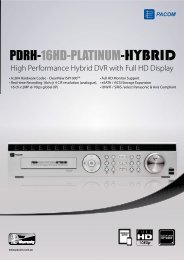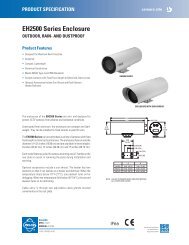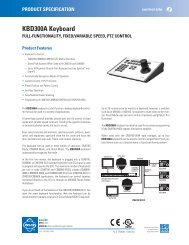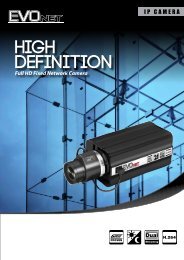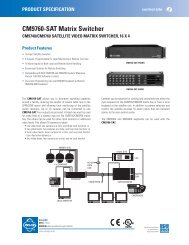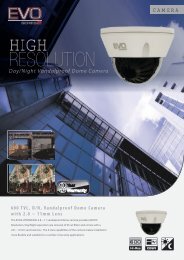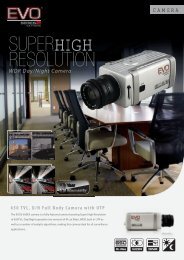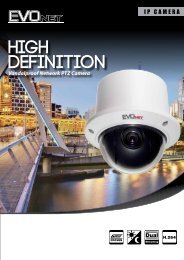Chapter 1 - Pacific Communications
Chapter 1 - Pacific Communications
Chapter 1 - Pacific Communications
Create successful ePaper yourself
Turn your PDF publications into a flip-book with our unique Google optimized e-Paper software.
User’s Manual<br />
− Device Information File: Allows you to import an .xml file which has device connection information<br />
and lists the devices. Ask your dealer or distributor for details about the .xml file.<br />
• : Select the devices to register by checking the box beside each device name in the list. Selecting<br />
the Select All box selects all devices in the list.<br />
NOTES:<br />
• Camera models that are supported will require the selection of the manufacturer protocol (SiRiS protocol<br />
for EVOnet) or the ONVIF TM Conformance protocol.<br />
• All camera models listed are supported by design and changes to their firmware/protocol/versions are subject<br />
to change without notice and if communication cannot be achieved, please consult the supplier for assistance.<br />
• Please refer to the camera’s manufacturer’s manual to enable ONVIF TM Conformance protocol, as procedures<br />
may differ for each model. Alternatively ask your supplier about supported models.<br />
2. Click the Add Devices button at the bottom.<br />
• Name, Address, Device Type: Displays the name, IP address and type of the selected device. The<br />
name will be updated automatically depending on the settings of the device.<br />
• ID, Password: Enter the user ID and password which you set in the device in order to connect to that<br />
device remotely. The connection to the device is allowed only to the users under the Administrator<br />
group of the device, and recording is allowed only to the admin and pacom users under the<br />
Administrator group of the device.<br />
• Recording Service: Select a recording service (supported only for the network video devices). The<br />
device is registered on the recording service and the recording service performs recording according<br />
to a recording schedule. The channel number of the recording service indicates the maximum number<br />
of cameras that can be registered, and the name indicates the name of a recording service, which was<br />
set during the Service menu setup. When selecting the Do not record option, the SiRiS program treats<br />
the device during the Schedule setup as though it was not registered and does not perform any of the<br />
scheduled activities associated with the device. If you delete the device from the recording service<br />
after some recording has been done, you cannot search or play back the previously recorded video<br />
though you register the device again. You can check the list of devices registered on the recording<br />
service on a Device Setup tab while setting up the recording service in the Service menu. Refer<br />
to <strong>Chapter</strong> 13 — Storage Management (p. 113) for details.<br />
• Streaming Service: Select whether or not to use the streaming service for monitoring video from the<br />
device. If the device uses the streaming service, the SiRiS program transmits video from the device<br />
to the client system through the streaming service, and it allows multiple users to monitor video<br />
simultaneously. When the device uses the streaming service, icon is displayed beside the device in<br />
the Site List of the SiRiS Client program. The number of channels that can be streamed equals the<br />
number of channels that can be recorded. Refer to <strong>Chapter</strong> 10 — Streaming (p. 91) for details.<br />
96



